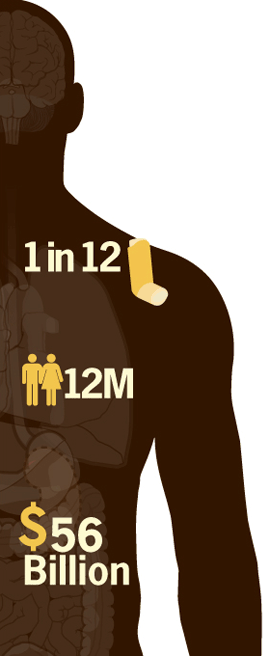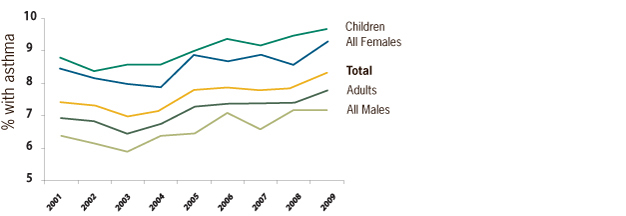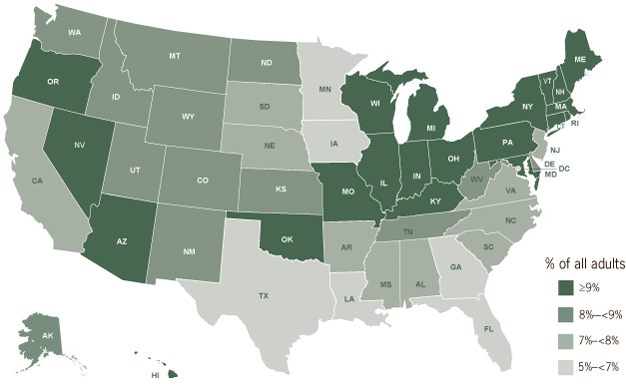
May 2011
Asthma in the US
Growing every year

Asthma is a lifelong disease that causes wheezing, breathlessness, chest tightness, and coughing. It can limit a person's quality of life. While we don't know why asthma rates are rising, we do know that most people with asthma can control their symptoms and prevent asthma attacks by avoiding asthma triggers and correctly using prescribed medicines, such as inhaled corticosteroids.
The number of people diagnosed with asthma grew by 4.3 million from 2001 to 2009. From 2001 through 2009 asthma rates rose the most among black children, almost a 50% increase. Asthma was linked to 3,447 deaths (about 9 per day) in 2007. Asthma costs in the US grew from about $53 billion in 2002 to about $56 billion in 2007, about a 6% increase. Greater access to medical care is needed for the growing number of people with asthma.
Latest Findings
Asthma is increasing every year in the US.
Too many people have asthma.
- The number of people with asthma continues to grow. One in 12 people (about 25 million, or 8% of the population) had asthma in 2009, compared with 1 in 14 (about 20 million, or 7%) in 2001.
- More than half (53%) of people with asthma had an asthma attack in 2008. More children (57%) than adults (51%) had an attack. 185 children and 3,262 adults died from asthma in 2007.
- About 1 in 10 children (10%) had asthma and 1 in 12 adults (8%) had asthma in 2009. Women were more likely than men and boys more likely than girls to have asthma.
- About 1 in 9 (11%) non-Hispanic blacks of all ages and about 1 in 6 (17%) of non-Hispanic black children had asthma in 2009, the highest rate among racial/ethnic groups.
- The greatest rise in asthma rates was among black children (almost a 50% increase) from 2001 through 2009.
Asthma Action Plan Stages
Green Zone: Doing Well
No cough, wheeze, chest tightness, or shortness of breath; can do all usual activities. Take prescribed longterm control medicine such as inhaled corticosteroids.
Yellow Zone: Getting Worse
Cough, wheeze, chest tightness, or shortness of breath; waking at night; can do some, but not all, usual activities. Add quick-relief medicine.
Red Zone: Medical Alert!
Very short of breath; quick-relief medicines don't help; cannot do usual activities; symptoms no better after 24 hours in Yellow Zone. Get medical help NOW.
Full Action Plan: http://www.cdc.gov/asthma/actionplan.html
Asthma has a high cost for individuals and the nation.
- Asthma cost the US about $3,300 per person with asthma each year from 2002 to 2007 in medical expenses.
- Medical expenses associated with asthma increased from $48.6 billion in 2002 to $50.1 billion in 2007. About 2 in 5 (40%) uninsured people with asthma could not afford their prescription medicines and about 1 in 9 (11%) insured people with asthma could not afford
their prescription medicines. - More than half (59%) of children and one-third (33%) of adults who had an asthma attack missed school or work because of asthma in 2008. On average, in 2008 children missed 4 days of school and adults missed 5 days of work because of asthma.
Better asthma education is needed.
- People with asthma can prevent asthma attacks if they are taught to use inhaled corticosteroids and other prescribed daily long-term control medicines correctly and to avoid asthma triggers. Triggers can include tobacco smoke, mold, outdoor air pollution, and colds and flu.
- In 2008 less than half of people with asthma reported being taught how to avoid triggers. Almost half (48%) of adults who were taught how to avoid triggers did not follow most of this advice.
- Doctors and patients can better manage asthma by creating a personal asthma action plan that the patient follows.
Who's At Risk?
Asthma by age and sex US, 2001-2009

Percentages are age-adjusted
SOURCE: National Center for Health Statistics; 2010.
Asthma self-management education by age, US, 2008

SOURCE: National Health Interview Survey, 2008, asthma supplement.
U.S. State Info
Adults with asthma in the US, 2009

SOURCE: Behavioral Risk Factor Surveillance System, 2009
What Can Be Done
Federal, state, and local health officials can:
- Track asthma rates and the effectiveness of control measures so continuous improvements can be made in prevention efforts.
- Promote influenza and pneumonia vaccination for people with asthma.
- Promote improvements in indoor air quality for people with asthma through measures such as smoke-free air laws and policies, healthy schools and workplaces, and improvements in outdoor air quality.
Health care providers can:
- Determine the severity of asthma and monitor how much control the patient has over it.
- Make an asthma action plan for patients. Use this to teach them how to use inhaled corticosteroids and other prescribed medicines correctly and how to avoid asthma triggers such as tobacco smoke, mold, pet dander, and outdoor air pollution.
- Prescribe inhaled corticosteroids for all patients with persistent asthma.
People with asthma and parents of children with asthma can:
- Receive ongoing appropriate medical care.
- Be empowered through education to manage their asthma and asthma attacks.
- Avoid asthma triggers at school, work, home, and outdoors. Parents of children with asthma should not smoke, or if they do, smoke only outdoors and not in their cars.
- Use inhaled corticosteroids and other prescribed medicines correctly.
Schools and school nurses can:
- Use student asthma action plans to guide use of inhaled corticosteroids and other prescribed asthma medicines correctly and to avoid asthma triggers.
- Make students' quick-relief inhalers readily available for them to use at school as needed.
- Take steps to fix indoor air quality problems like mold and outdoor air quality problems such as idling school buses.
Employers and insurers can:
- Promote healthy workplaces by reducing or eliminating known asthma triggers.
- Promote measures that prevent asthma attacks such as eliminating co-payments for inhaled corticosteroids and other prescribed medicines.
- Provide reimbursement for educational sessions conducted by clinicians, health educators, and other health professionals both within and outside of the clinical setting.
- Provide reimbursement for long-term control medicines, education, and services to reduce asthma triggers that are often not covered by health insurers.
Contact Us:
- Centers for Disease Control and Prevention
1600 Clifton Rd
Atlanta, GA 30333 - 800-CDC-INFO
(800-232-4636)
TTY: (888) 232-6348 - cdcinfo@cdc.gov



